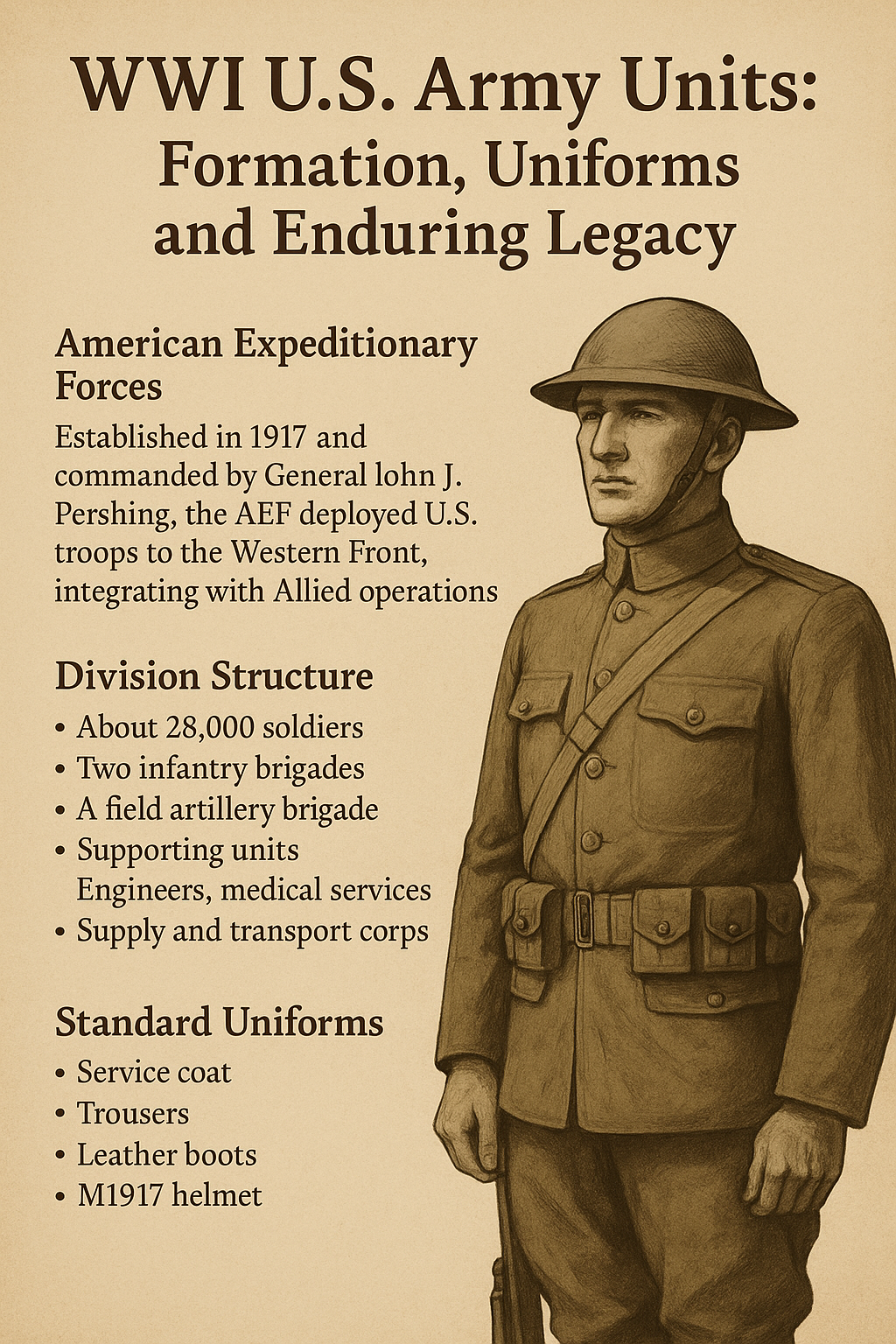
WWI U.S. Army Units: Formation, Uniforms, and Enduring Legacy
Published on Apr 24, 2025
WWI U.S. Army Units: Formation, Uniforms, and Enduring Legacy
Introduction
World War I was a pivotal moment in American military history. When the United States entered the conflict in 1917, it was quickly thrust into a global battle that demanded rapid expansion and reorganization of its armed forces. This transformation birthed a range of distinct U.S. Army units, a standardized uniform design, and equipment that would influence generations of soldiers, all while cementing a military aesthetic that lives on in ceremonial dress and modern reenactments.
At the heart of this transformation was not just strategy or size—but uniform identity. From the durable olive drab service coat to the steel M1917 helmet, the WWI American soldier became a symbol of resilience and duty.
The Rise of the American Expeditionary Forces (AEF)
When the U.S. joined WWI, it had a relatively small standing army. That changed almost overnight. Under the leadership of General John J. Pershing, the American Expeditionary Forces (AEF) were established to deploy soldiers to the European front.
Unlike European divisions, which often consisted of 12,000 to 15,000 men, American divisions were far larger, averaging around 28,000 troops. This robust size was intended to promote self-sufficiency and greater tactical flexibility.
Each division typically included:
- Two infantry brigades (each with two infantry regiments)
- One field artillery brigade
- Engineer, medical, and signal battalions
- Support units such as transport and logistics
These divisions were organized to operate semi-independently, giving American commanders more autonomy during operations.
Key U.S. Army Divisions of WWI
Some divisions gained particular notoriety for their bravery and effectiveness in battle. Examples include:
- 1st Infantry Division (The Big Red One) – The first to land in France and the last to return, this division set the tone for American involvement in the war.
- 42nd Infantry Division (Rainbow Division) – Comprised of National Guard units from multiple states, it symbolized unity and diversity across America.
- 93rd Infantry Division (Colored) – An African American division that fought under French command due to segregation in U.S. forces, highlighting both the progress and prejudice of the era.
These divisions didn't just fight—they helped forge the modern American military identity.
Uniforms of the WWI U.S. Army
The American soldier's appearance was a key part of his identity. The standard WWI uniform was practical, durable, and visually distinct from European forces.
Key Uniform Elements
- Service Coat: Olive drab wool with brass buttons and a high, stiff collar.
- Trousers: Matching wool trousers often paired with puttees (leg wrappings) for protection and support.
- Shirt: A flannel pullover shirt in a lighter shade of olive, offering warmth and comfort.
- Boots: Sturdy, hobnailed leather boots designed for trench conditions.
The uniform was designed not only for utility but also to create a recognizable, professional appearance among allies and foes alike.
The M1917 Helmet
Based on a British design, the M1917 helmet was America’s first standard-issue combat helmet. Its bowl-like shape and steel construction provided protection from shrapnel and debris. It quickly became a symbol of the American “Doughboy”—a name given to U.S. infantrymen of the era.
Headgear and Helmets: From Trenches to Traditions
Headgear during WWI wasn’t just about safety—it was also about identity. The M1917 helmet served on the battlefield, but after the war, ceremonial headgear began to develop its own traditions.
This laid the foundation for post-war and WWII headgear designs, including styles that would influence the army service uniform headgear still seen in modern dress blues.
Influence on Modern Military Uniforms
The uniforms developed during WWI directly influenced later designs. For example, the World War 2 RAF uniform would carry forward the principles of practicality and formality. The smart lines and fitted designs of British and American uniforms became iconic during WWII.
Even in today’s military attire—such as the ceremonial green beret dress blues—the echoes of WWI design persist. The beret, once just a practical item, has become a powerful symbol of elite service. Meanwhile, the structured appearance and material quality of modern dress blues pay homage to early 20th-century military fashion.
WWI Legacy in Collecting and Reenactment
The detailed and disciplined aesthetic of WWI uniforms has made them a favorite among collectors and reenactors. Whether it’s the sharp wool coats, M1917 helmets, or divisional patches, enthusiasts strive for authenticity in preserving and celebrating this crucial era.
If you're passionate about military history, historical reenactments, or just appreciate the timeless look of early U.S. military gear, reproductions of these uniforms offer a way to connect with history—while supporting craftsmanship and storytelling.
Conclusion
The U.S. Army’s rapid transformation during World War I laid the groundwork for the modern military we recognize today. From the formation of massive combat divisions to the adoption of standardized uniforms like the M1917 helmet and service coat, WWI was a turning point in military organization and visual identity.
As we reflect on these developments, it's clear that the legacy of WWI U.S. Army units lives on—not only in history books but also in the uniforms and traditions we continue to honor.
